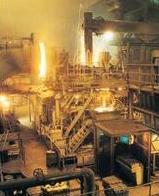Electric Arc Furnace发表评论(0)编辑词条
An electric arc furnace (EAF) is a furnace that heats charged material by means of an electric arc.
Arc furnaces range in size from small units of approximately one ton capacity (used in foundries for producing cast iron products) up to about 400 ton units used for secondary steelmaking. Arc furnaces used in research laboratories and by dentists may have a capacity of only a few dozen grams. Electric arc furnace temperatures can be up to 1,800 degrees Celsius. Arc furnaces differ from induction furnaces in that the charge material is directly exposed to the electric arc, and the current in the furnace terminals passes through the charged material.
Construction编辑本段回目录
An electric arc furnace used for steelmaking consists of a refractory-lined vessel, usually water-cooled in larger sizes, covered with a retractable roof, and through which one or more graphite electrodes enter the furnace. The furnace is primarily split into three sections:
• the shell, which consists of the sidewalls and lower steel 'bowl';
• the hearth, which consists of the refractory that lines the lower bowl;
• the roof, which may be refractory-lined or water-cooled, and can be shaped as a section of a sphere, or as a frustum (conical section). The roof also supports the refractory delta in its centre, through which one or more graphite electrodes enter.
The hearth may be hemispherical in shape, or in an eccentric bottom tapping furnace (see below), the hearth has the shape of a halved egg. In modern meltshops, the furnace is often raised off the ground floor, so that ladles and slag pots can easily be maneuvered under either end of the furnace. Separate from the furnace structure is the electrode support and electrical system, and the tilting platform on which the furnace rests. Two configurations are possible: the electrode supports and the roof tilt with the furnace, or are fixed to the raised platform.
A typical alternating current furnace has three electrodes. Electrodes are round in section, and typically in segments with threaded couplings, so that as the electrodes wear, new segments can be added.
Operation编辑本段回目录
Scrap metal is delivered to a scrap bay, located next to the melt shop. The scrap is loaded into large buckets called baskets, with 'clamshell' doors for a base. The scrap basket is then taken to the melt shop, the roof is swung off the furnace, and the furnace is charged with scrap from the basket. After charging, the roof is swung back over the furnace and meltdown commences. An important part of steelmaking is the formation of slag, which floats on the surface of the molten steel. Once flat bath conditions are reached, i.e. the scrap has been completely melted down, another bucket of scrap can be charged into the furnace and melted down, although EAF development is moving towards single-charge designs. Once the temperature and chemistry are correct, the steel is tapped out into a preheated ladle through tilting the furnace.
Advantages of electric arc furnace for steelmaking编辑本段回目录
The use of EAFs allows steel to be made from a 100% scrap metal feedstock, commonly known as 'cold ferrous feed' to emphasise the fact that for an EAF, scrap is a regulated feed material. The primary benefit of this is the large reduction in specific energy (energy per unit weight) required to produce the steel. Another benefit is flexibility: while blast furnaces cannot vary their production by much and are never stopped, EAFs can be rapidly started and stopped, allowing the steel mill to vary production according to demand. Although steelmaking arc furnaces generally use scrap steel as their primary feedstock, if hot metal from a blast furnace or direct-reduced iron is available economically, these can also be used as furnace feed.
A typical steelmaking arc furnace is the source of steel for a mini-mill, which may make bars or strip product. Mini-mills can be sited relatively near to the markets for steel products, and the transport requirements are less than for an integrated mill, which would commonly be sited near a harbour for access to shipping.
电炉编辑本段回目录
电炉设备通常是成套的,包括电炉炉体,电力设备(电炉变压器、整流器、变频器等),开闭器,附属辅助电器(阻流器、补偿电容等),真空设备,检测控制仪表(电工仪表、热工仪表等),自动调节系统,炉用机械设备(进出料机械、炉体倾转装置等)。大型电炉的电力设备和检测控制仪表等一般集中在电炉供电室。同燃料炉比较,电炉的优点有:炉内气氛容易控制,甚至可抽成真空;物料加热快,加热温度高,温度容易控制;生产过程较易实现机械化和自动化;劳动卫生条件好;热效率高;产品质量好等。冶金工业上电炉主要用于钢铁、铁合金、有色金属等的熔炼、加热和热处理。19世纪末出现了工业规模的电炉,20世纪50年代以来,由于对高级冶金产品需求的增长和电费随电力工业的发展而下降,电炉在冶金炉设备中的比额逐年上升。电炉可分为电阻炉、感应炉、电弧炉、等离子炉、电子束炉等。
电阻炉 以电流通过导体所产生的焦耳热为热源的电炉。
感应炉 利用物料的感应电热效应而使物料加热或熔化的电炉。感应炉的基本部件是用紫铜管绕制的感应圈。
电弧炉 利用电弧热效应熔炼金属和其他物料的电炉。按加热方式分为三种类型:①间接加热电弧炉。
等离子炉 利用工作气体被电离时产生的等离子体来进行加热或熔炼的电炉。
电子束炉 用高速电子轰击物料使之加热熔化的电炉。
与“Electric arc furnace,电炉”相关的词条
→如果您认为本词条还有待完善,请 编辑词条
词条内容仅供参考,如果您需要解决具体问题
(尤其在法律、医学等领域),建议您咨询相关领域专业人士。
0

同义词: 暂无同义词
关于本词条的评论 (共0条)发表评论>>








